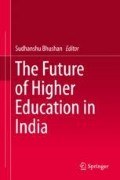Abstract
In the wake of higher education experiencing massive expansion, GER (Gross Enrolment Ratio) being 25.8%, on the one hand, and numerous anomalies like deteriorating teaching-learning quality, on the other, have led to the mushrooming of private coaching. It has, in turn, contributed in magnifying distortions in the realm of higher education, further eroding its public good nature. In this context, this chapter draws from NSS 71st round unit-level records, schedule 25.2, pertaining to Social Consumption: Education (2014–15) and makes an attempt to capture the pattern and cost (at the household level) of private coaching in India for higher educated individuals pertaining to the age group 18–23 years across social groups, gender, location, type of institutions and MPCE quintiles. Then, it eventually captures various social, economic, educational and locational factors influencing household expenditure on private coaching using a Tobit model for the entire country, which has been further disaggregated at the level of rural and urban sectors.
Access this chapter
Tax calculation will be finalised at checkout
Purchases are for personal use only
Notes
- 1.
These figures have been calculated by the authors from NSS 71st round unit-level records.
- 2.
The study by Sen (2009) pointed out that in case of school education, 54% of parents in West Bengal who could not send their children to private coaching was because they could not afford it.
- 3.
Though, for rural and urban sectors, the coefficients are insignificant.
- 4.
This study was based on 4031 samples of secondary school students across four states (Kerala, Maharashtra, Andhra Pradesh and Uttar Pradesh).
- 5.
The same figures for Northern region are Rs. 2777.20, Northeast is Rs. 2824.91 and is least for the southern region at Rs. 1306.80.
References
Alcott, B., & Rose, P. (2015). Schools and learning in rural India and Pakistan: Who goes where and how much are they learning? Prospects, 45, 345–363.
Aslam, M. & Atherton, P. (2012). The shadow education sector in India and Pakistan: The determinants, benefits and equity effects of private tutoring. ESP Working paper Series, 38. http://www.periglobal.org/sites/periglobal.org/files/WP38_Aslam&Atherton.pdf. Last Accessed on 3/9/2017.
Aurini, J. (2004). Educational entrepreneurialism in the private tutoring industry: Balancing profitability with the humanistic face of schooling. Canadian Review of Sociology, 41(4), 475–491.
Bhushan, S. (2009). Restructuring higher education in India. Jaipur: Rawat Books.
Biswal, B. P. (1999). Private tutoring and public corruption: A cost-effective education for developing countries. The Developing Economies, 37(2), 222–240.
Bray, M. (1999). The shadow education system: Private tutoring and its implications for planners. Fundamentals of educational planning no. 61. Paris: UNESCO International Institute for Educational Planning (IIEP).
Bray, M. (2003). Adverse effects of private supplementary tutoring: Dimensions, implications, and government responses. Paris: UNESCO International Institute for Educational Planning.
Bray, T. M. (2009). Confronting the shadow education system: What government policies for what private tutoring? Paris: IIEP.
Bray, M., & Kwok, P. (2003). Demand for private supplementary tutoring: Conceptual considerations and socio-economic patterns in Hong Kong. Economics of Education Review, 22, 611–620.
Buchmann, C., Condron, D. J., & Roscigno, V. J. (2010). Shadow education, American style: Test preparation, the SAT and college enrollment. Social Forces, 89(2), 435–461.
Dongre, A, Tewary, V (2014). Impact of private tutoring on Learning Levels: Evidence from India. Accountability Initiative working paper series. http://www.educationforallinindia.com/ambirsh_dongre_vibhu_tewary_impact_of_private_tutoring-on_learninglevels_accountability_initiative.pdf. Last Accessed on 3/9/2016.
Global Industry Analyst. (2016). Intense competition among students and the growing need to achieve academic excellence drive the global private tutoring market. Http://Www.Strategyr.Com/Marketresearch/Private_Home_Tutor_Services_Market_Trends.Asp. Last accessed on 3/9/2017.
Goyal, Y. (2019). A policy to regulate coaching centres. The Hindu.
Jonatahan, R. (1990). State education service or Prisoner’s dilemma: The ‘hidden hand’ as source of education policy. Educational Philosophy, 22, (1) 16–(1) 24.
Kim, S., Lee, Ju-Ho. (2001). Demand for education and developmental state: Private tutoring in South Korea. Social Science Research Network Electronic Paper. https://papers.ssrn.com/sol3/papers.cfm?abstract_id=268284. Last accessed on 3/9/2017.
Lakshmanasamy, T. (2017). Demand for private tuition – A quantile regression analysis of household expenditure on private coaching in India. Journal of educational Planning and Administration, 31(2), 115–139.
Ministry of Human Resource and Development. (2016). Private tuition: Extent pattern and determinants. New Delhi: Government of India.
Ministry of Human Resource and Development. (2018). All India survey on higher education. New Delhi: Government of India.
Psacharopoulos, G., & Papakonstantinou, G. (2005). The real university cost in a “free” higher education country. Economics of Education Review, 24(1), 103–108.
Sabharwal, N., Malish, C. M. (2017). Achieving Academic Integration in Higher Education in India. Centre for Policy research in Higher Education, Policy Brief 2, NUEPA.
Sen, A. (2002). Introduction. In Pratichi education report: A study in West Bengal. New Dehli: Pratichi Research Team.
Stevenson, D. L., & Baker, D. P. (1992). Shadow education and allocation in formal schooling: Transition to university in Japan. American Journal of Sociology, 97(6), 1639–1657.
Sujatha, K. (2014). Private tuition in India: trends and issues. Revue internationale d’éducation de Sèvres. http://ries.revues.org/3796. Last accessed on 3/9/2017.
Tansel, A., & Bircan, F. (2006). Demand for education in Turkey: A Tobit analysis of private tutoring expenditures. Economics of education review., 25(3), 303–313.
Tansel, A., & Bircan Bodur, F. (2005). Effect of private tutoring on university entrance examination performance in Turkey. IZA.DP 1609.
Tilak, J. B. (2004). Public subsidies in education in India. Economic and Political Weekly, 343–359.
Author information
Authors and Affiliations
Editor information
Editors and Affiliations
Appendix
Appendix
Rights and permissions
Copyright information
© 2019 Springer Nature Singapore Pte Ltd.
About this chapter
Cite this chapter
Mitra, A., Sarkar, N. (2019). Factors Influencing Household Expenditure on Private Tutoring in Higher Education. In: Bhushan, S. (eds) The Future of Higher Education in India. Springer, Singapore. https://doi.org/10.1007/978-981-32-9061-7_12
Download citation
DOI: https://doi.org/10.1007/978-981-32-9061-7_12
Published:
Publisher Name: Springer, Singapore
Print ISBN: 978-981-32-9060-0
Online ISBN: 978-981-32-9061-7
eBook Packages: EducationEducation (R0)

